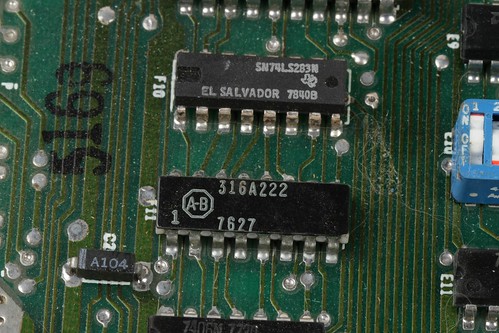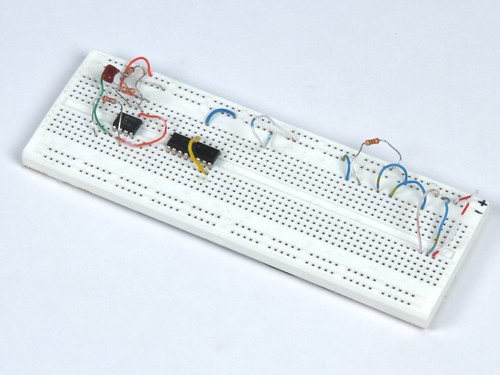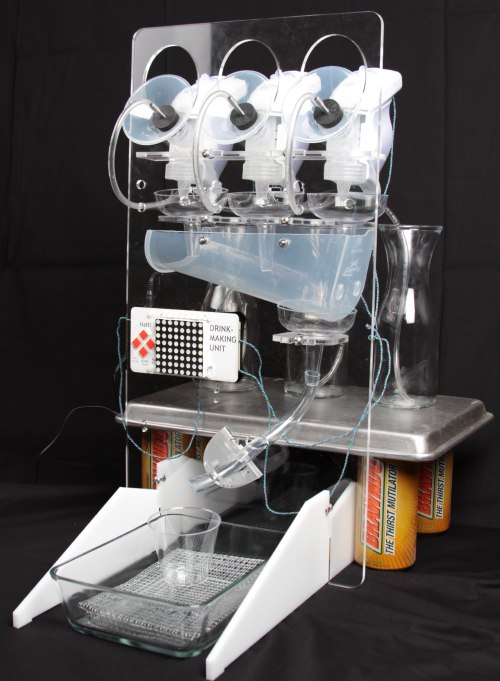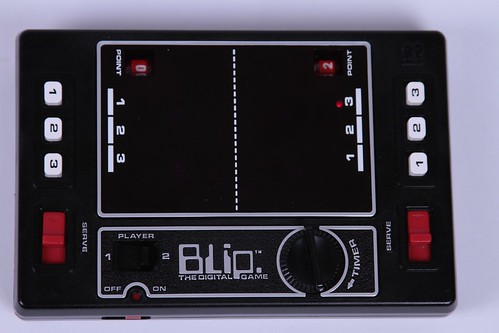You’ve got your components, and your datasheet, and you’re read to start hacking. But which way does the chip go? Pin 23 is where? If you’re lucky, the orientation is clearly marked, or perhaps diagrammed in the datasheet. But if it isn’t, or if you’re simply new at this, it’s helpful to know what to look for. Continue reading Basics: Finding pin 1
Faking it: seven-segment displays
A sordid tale, starting in the bedroom, involving batteries, deceit, cheap tricks, LEDs, and a pot.
Continue reading Faking it: seven-segment displays
Mailbag: Moving from breadboard to protoboard
Ryan writes in,
| “I have a question about moving a project off a bread board and onto a project or perf board. Basically what is the best way to do without a lot of rework? This will be my first time doing this and I was just wondering if there were any best practices so that the final product looks clean and organized and I don’t have mountains of solder on the back side.” |
And it’s a good question.
Continue reading Mailbag: Moving from breadboard to protoboard
A scarf to aid your search for terrestrial intelligence
The Arecibo Message, one of the most famous messages transmitted as part of SETI, loosely translated, says: “Hi! We’re intelligent! We’re made of meat! Here’s where we live!” Binary designs like the Arecibo message are popular with knitters and cross-stitchers since they can be pixelated easily. We found a pair of fingerless gloves, based on a muffler pattern. We think this type of binary pattern would be good for the message as well. It has also been made into a cross-stitched bookmark. We implemented the embroidered pixels as columns of satin stitching in a single color. The original binary message didn’t have any of the color coding that people have added to help explain it, and it seems more elegant to keep it this way. We machine embroidered the pattern on both ends of a piece of linen about 14″ x 76″. The linen is then sewn together on the back and at the ends, and turned right side out. The edges are stitched down to help it lie flat.
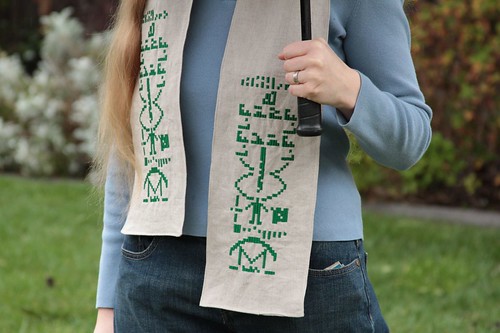
The embroidery design is about 3.5″ x 11.5″. We’re providing a couple of different embroidery formats for those with access to machines as well as a .pdf for cross stitch, hand embroidery, laser engraving, or whatever else you can think to do with it.
If you are inspired by the message or use one of the patterns, we’d love to see the results in the flickr auxiliary.
And… we’re back.
We’re just wrapping up a series of site upgrades, including migration to a new host (Linode) that should greatly improve our speed and availability.
Thanks for your patience as we smash a few last bugs– it’s been a busy weekend.
Drink Making Unit
One of the many kinds of machines that we have never made before is a cocktail robot. But recently, after being invited to participate in Barbot 2010, we put together this little drink mixer.
Cocktail robots are a funny breed. No two seem to work the same way and many (like ours) have few enough moving parts to barely count as robots at all. The granddaddy cocktail robotics event is Roboexotica (for which you can read about last years robots here), but we’re showing off our machine tonight and tomorrow night, much closer to home at the DNA lounge in San Francisco.
Continue reading Drink Making Unit
Linkdump: February 2010
- Crayon rockets!
- The original rolling ball clock — now available again!
- Also, ever seen the Arrow coin clock?
- Attention BF programmers that want better 3D graphics support: The bfopengl project needs more developers.
- Al Gore changes font (via)
- Food science: Why fry fries twice?
- Fordson Snow Machine from 1929 (on YouTube) (via)
- Virtual radar — Google maps + planes over Europe
- Measuring the ink used by different fonts, the analog way.
- Awesome Hopping Robot
- Self-slicing Pizza and many other interesting projects
- Multiwire circuit boards (link goes to patent). Fascinating older, specialized technology that was actually used. You can get a good idea what it’s all about from the illustrations in the PDF.
- We’re excited to see some hints that open-source embroidery may happen someday.
- Sea glass candy
- Awesome LED earrings at Etsy
- Gear generator program by Matthias Wandel; video demo here. Would be fully awesome except that it’s for Windows only. (A simple, online version is available here.)
- Make a tasty Ice Planet
- Remaking classic perpetual motion machines, at the Museum of Unworkable Devices.
- Interesting perspective: Is luck a skill?
- Some nice looking wooden notebooks
Evil Mad Scientist at Rods and Mods
While we don’t normally find ourselves as part of the case mod community, we’ve been invited to participate in the Rods and Mods event, “The Kustom Kulture of Radical Computer Modification” currently going on, Thursday through Saturday at the Exploratorium in San Francisco. We’ll be attending this Saturday, showing off some of our recent projects and maybe even some hacked devices.
You can read more about this event here, and we’ll hope to see you there!What makes Blip tick?
After our Tabletop Pong project, someone suggested that we should check out the Tomy Blip, a handheld game dating to 1977.
And so we did. We snagged one on eBay, and here it is: “Blip, the digital game.”
Blip is unlike any other handheld that I’ve played, and (as you’ll see) it’s quite a piece of engineering. In what follows, we give it a test drive, and then take it apart and see what makes it tick.
Continue reading What makes Blip tick?




